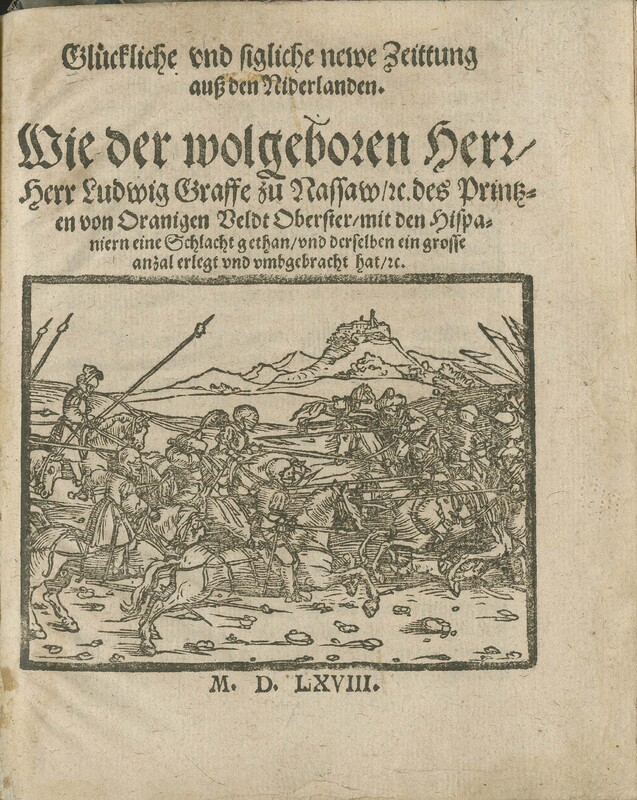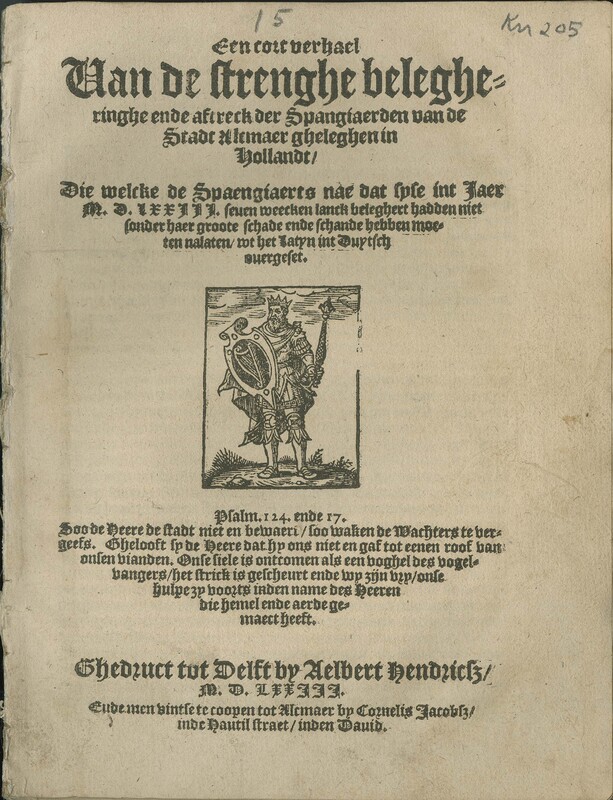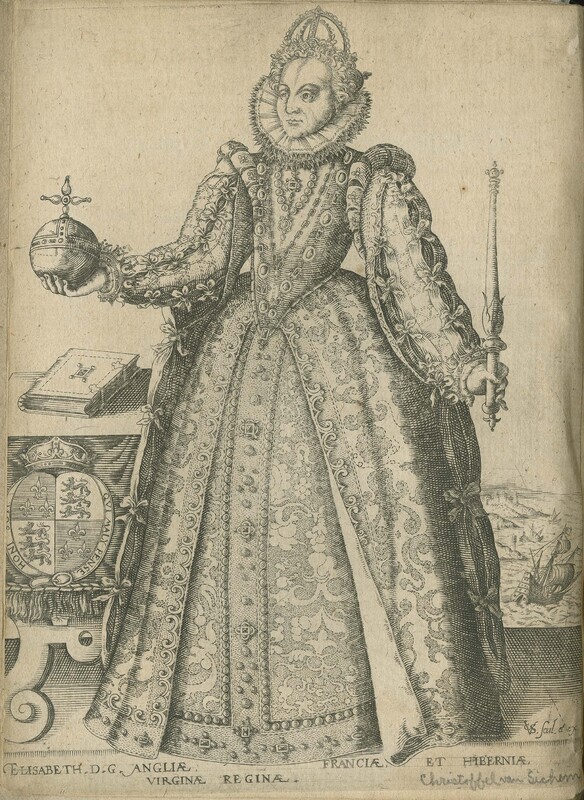The Revolt against the Spanish Rulers (1556-1648): Battles, Sieges, and Treaties
In 1556, Charles V abdicated, transferring the Netherlands and Spain to his son Philip, whose reign (1556-1598) witnessed a long bloody conflict between the Spanish monarchy and the Dutch subjects seeking their independence from Spain. The so-called Eighty Years' War (1568-1648) led to the separation of the northern and southern Netherlands, culminating with the formation of the United Provinces of the Netherlands. The pamphlets displayed in this section highlight, for example, some specific conflicts within this long struggle, such as the Battle of Heiligerlee (1568) and the Siege of Alkmaar (1573).
The title page includes a woodcut depicting a generic representation of a battle between two cavalries in full armor. As the title of the pamphlet indicates, this illustration would refer to the battle of Heiligerlee, May 23, 1568, in which the rebel army led by two brothers of William I of Orange, Lodewijk and Adolf of Nassau, defeated the Spanish army in the northern province of Friesland. The caption of the woodcut says "M. D. LXVIII", that is, 1568, the date of both the battle and the publication of the pamphlet.
The woodcut illustration of the title page depicts King David wearing sixteenth-century armor, and holding his lyre in his right hand and a scepter in his left hand. Below the woodcut is a quotation in Dutch from the beginning of Psalm 127. The English translation is: "Unless the Lord guards the city, the guards watch in vain."And the rest of the quotation is taken from the last sentences of Psalm 124, as indicated in the caption of the woodcut. The English translation is: "Praise be to the Lord, who has not let us be torn by their teeth. We have escaped like a bird from the fowler's snare; the snare has been broken, and we have escaped. Our help is in the name of the Lord, the Maker of heaven and earth."
As worded in the title page, this pamphlet is an account by Nanning van Foreest (1529-1592) of the Siege of Alkmaar, a turning point in the Dutch Revolt or also called the Eighty Years' War. The burghers of the Dutch held off the Spanish between 21 August and 8 October 1573.
The title page of this pamphlet includes a woodcut plausibly representing a version of the coat of arms of the city of Utrecht, as suggested by a shield divided diagonally into two halves, with a darkened lower half. The shield is surrounded by a garland of flowers. This central woodcut is flanked by two column-like ornamental woodcuts. The wording of the title page summarizes the content of the pamphlet. On 29 January 1579, the Seven Provinces (Holland, Zeeland, Utrecht, Friesland, Groningen, Overrjsel, and Gelderland) signed the Union of Utrecht, which created the Republic of the United Provinces with William I, Prince of Orange, as King. While each province kept a certain degree of autonomy, they agreed to cooperate in their defense and to have a common voice in European affairs.
Full-page engraving depicting a full-length portrait of Queen Elizabeth I. Luxuriously dressed, she holds a globe topped with a cross in her right hand and a scepter in her left hand. On her right is a table with a book, covered with a cloth displaying the coat of arms of the Tudor family. The background shows the sea and a ship departing the coast.
reaty between Elizabeth I of England and the United Provinces, signed on August 10, 1585, in which she agrees to send troops to aid the Netherlands against Spain.
The top section of the title page reproduces the title of a pamphlet published in the previous year, 1598: Aende Afghewekene Provincien van Hollant, Zeelandt, etc, ("To the seceded provinces of Holland, Zeeland, etc."), followed by a quote from Deuteronomy 32. In contrast, the second section of the title page presents a strong rebuttal: Aenwysinghe opt vermaen vande verleyde ende overheerde Provintien van Nederlandt ghedaen aen de vereenigde Nederlanden ("Corrective to the admonishment made by the misled and subjugated Netherlands to the United Netherlands"). Additionally, the title page features a copperplate engraving partly inspired by Aesop's fable, "The Fox without a Tail." Depicted is a fox who, having lost its tail in a trap, attempts to convince a group of foxes that they should cut their tails because they do more harm than good; meanwhile, in the background, a birdcatcher lurks behind a tree, trying to ensnare birds in his net. Both the fable and the birdcatcher serve as allegories, symbolizing those in the Southern (Spanish) Netherlands who sought to entice their northern brothers to ignore the harm caused by the Spaniards and join them in servitude.
The quoted pamphlet of 1598, authored by an anonymous writer sympathetic to the Spanish cause and advocating peace with Spain, rebuts the arguments put forth by the Dutch against signing a peace treaty with Spain. Subsequently, the pamphlet on display, published in 1599, references the arguments presented in the earlier pamphlet, including specific chapters and line references, to refute the pro-Spain arguments from the perspective of the United Provinces.
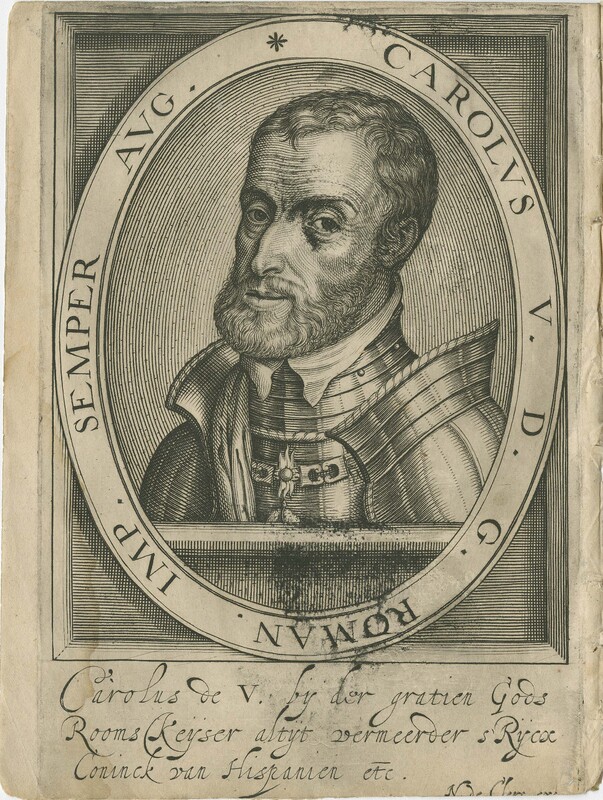
The Revolt against the Spanish Rulers (1556-1648): The Actors
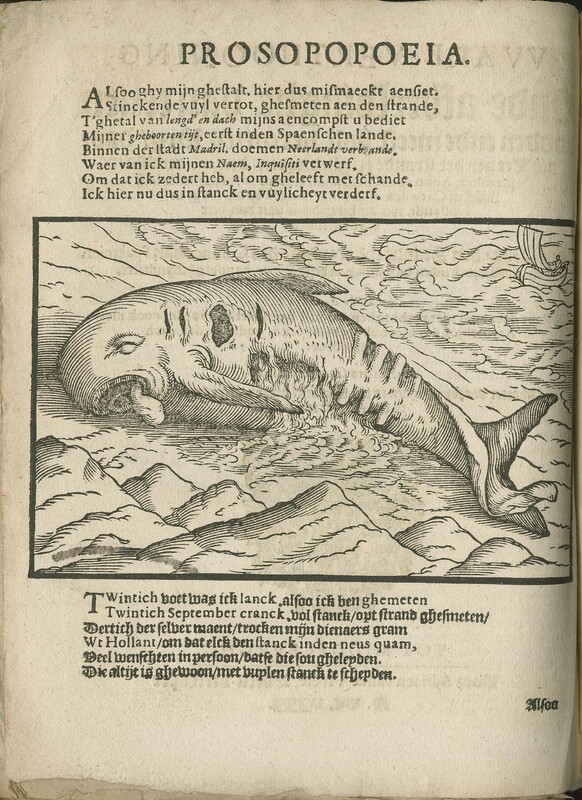
Religious Battles during The Twelve Years Truce (1609-1621)

